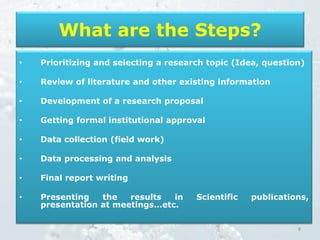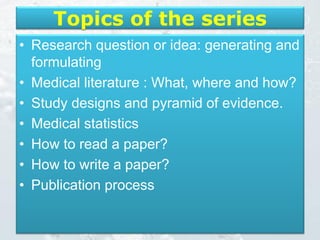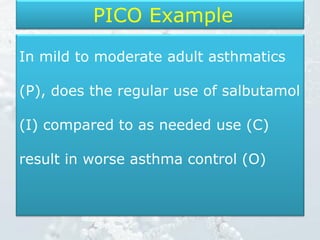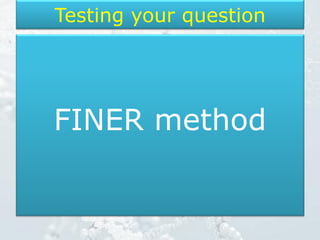Clinical research ( intro and research question)
- 1. 1 Clinical Research Basics Mohamed Fahmy Doheim M.B.B.Ch Candidate
- 3. What is research? ŌĆó Systematic investigation to establish facts or principles or to collect information on a subject. ŌĆó Research is the systematic collection, analysis and interpretation of data to answer a certain question or solve a problem.
- 6. Purposes of research ŌĆó Exploration ŌĆó Description ŌĆó Explanation
- 7. 7 What are the Steps? ŌĆó Prioritizing and selecting a research topic (Idea, question) ŌĆó Review of literature and other existing information ŌĆó Development of a research proposal ŌĆó Getting formal institutional approval ŌĆó Data collection (field work) ŌĆó Data processing and analysis ŌĆó Final report writing ŌĆó Presenting the results in Scientific publications, presentation at meetingsŌĆ”etc.
- 8. 8 What are the Steps? ŌĆó Prioritizing and selecting a research topic (Idea, question) ŌĆó Review of literature and other existing information ŌĆó Development of a research proposal ŌĆó Getting formal institutional approval ŌĆó Data collection (field work) ŌĆó Data processing and analysis ŌĆó Final report writing ŌĆó Presenting the results in Scientific publications, presentation at meetingsŌĆ”etc.
- 9. Topics of the series ŌĆó Research question or idea: generating and formulating ŌĆó Medical literature : What, where and how? ŌĆó Study designs and pyramid of evidence. ŌĆó Medical statistics ŌĆó How to read a paper? ŌĆó How to write a paper? ŌĆó Publication process
- 10. !LetŌĆÖs start Formulation of Research Question
- 11. Our Aim Good Idea Answerable research question
- 12. Research idea ŌĆó Research idea provides the very basic foundation of research work ŌĆó Good idea ---- good research
- 13. 1- Picking up the research idea A) Reading literature B) Clinical practice and observation
- 14. A) Reading literature: ŌĆó When we read the literature, we usually will find some gaps and questions that need to be answered and some results that need to be confirmed. ŌĆó That's usually will come from the discussion part and the "recommendations" which the authors have proposed for further research. ŌĆó Here, the most important thing u will need is caring reading and critical thinking to generate your question.
- 15. Critical thinking 17+18 (is/are) 26? IS or ARE?
- 16. B) Clinical practice and observation: ŌĆó During clinical practice, you may find a case or cases admitted with some manifestations and passed many stages to reach the diagnosis and u may report as it is not classical (Case report or series). ŌĆó Moreover, you may observe something and generate and test your hypothesis (Finding a correlation)
- 17. Useful Techniques ŌĆó Rational thinking ŌĆó Creative thinking ŌĆó Searching the literature ŌĆó Scanning the media ŌĆó Brainstorming ŌĆó Exploring past projects ŌĆó Discussion ŌĆó Keeping an ideas notebook
- 18. Ranking of research topics Rating Sheet For Group Work Total Criteria for selection of research topic Proposed topic Ethical acceptability Urgency of data needed ApplicabilityPolitical acceptability FeasibilityAvoidance of duplication Relevance 1. 2. 3. 4. 5. Rating scale: 1 = low, 2 = medium, 3 = high.
- 20. PICO ŌĆó Population, Patient, Problem P ŌĆó Intervention or Indicator I ŌĆó Comparator or Control C ŌĆó Outcome O
- 21. PECO ŌĆó Population, Patient, Problem P ŌĆó Exposure E ŌĆó Comparator or Control C ŌĆó Outcome O
- 22. PICO Example In mild to moderate adult asthmatics (P), does the regular use of salbutamol (I) compared to as needed use (C) result in worse asthma control (O)
- 23. Testing your question FINER method
- 24. FINER ŌĆó Feasible: adequate subject, expertise, affordable ŌĆó Interesting: to the investigator ŌĆó Novel: confirm, extend or refute previous findings and provide new findings ŌĆó Ethical: fulfill guidelines for the protection ŌĆó Relevant: to scientific knowledge
- 25. Broad or narrow? Research question could be broad, intermediate or narrow question: ŌĆó Broad: Efficacy of treatments of spinal muscular atrophy. ŌĆó Intermediate: Efficacy of VPA for spinal muscular atrophy. ŌĆó Narrow: Efficacy of VPA for spinal muscular atrophy type 2.
- 26. Formulating a hypothesis ŌĆó Adopted by the researcher is referred to as (Alternative Hypothesis; H1) ŌĆó The opposite event is referred to as (Null hypothesis; H0). ŌĆó Directional or not?


























